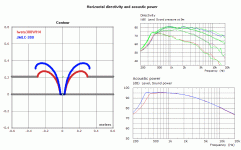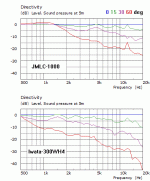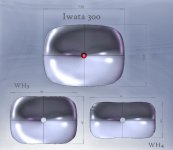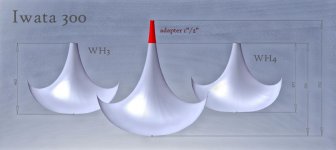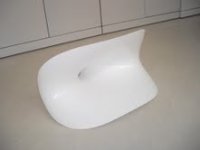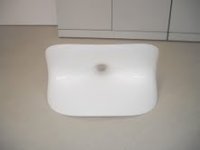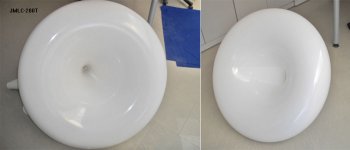*** JMLC Spreadsheet needed for a rectangular throat.
Hi guys. Can somebody help me?
I would like to introduce in my system the ribbon tweeter Pyramid T-1 (or Sequerra if you prefer). And I would like to interface by a JMLC profile.
The problem I have is the emission surface, the ribbon, is a rectangle, think to 3 cm width and 20 cm tall. Dispersion is 90° and 130° (I am looking to the main guide now. I will check the right sizes when I will approach the definitive drawings. They are in the loft of the house and I am far away).
What's the useful spreadsheet? Is there something for the rectangular throat?
My medium is a TAD 4001 loaded with a JMLC horn made by Łukasz Lewandowski of Auto-Tech Poland (still on the way). Later I will try with the TAD 2001 (I have both).
The system is multi-amplificated.
The experiment would demonstrate if the T-1 is really the tweeter somebody writes. I have a pair. So why don't try. Now a pair of Coral H104 is working fine.
Any suggestion?
Thanks.
Mario Canever
Hi guys. Can somebody help me?
I would like to introduce in my system the ribbon tweeter Pyramid T-1 (or Sequerra if you prefer). And I would like to interface by a JMLC profile.
The problem I have is the emission surface, the ribbon, is a rectangle, think to 3 cm width and 20 cm tall. Dispersion is 90° and 130° (I am looking to the main guide now. I will check the right sizes when I will approach the definitive drawings. They are in the loft of the house and I am far away).
What's the useful spreadsheet? Is there something for the rectangular throat?
My medium is a TAD 4001 loaded with a JMLC horn made by Łukasz Lewandowski of Auto-Tech Poland (still on the way). Later I will try with the TAD 2001 (I have both).
The system is multi-amplificated.
The experiment would demonstrate if the T-1 is really the tweeter somebody writes. I have a pair. So why don't try. Now a pair of Coral H104 is working fine.
Any suggestion?
Thanks.
Mario Canever
Hi, I studied and I replied by myself, but can somebody share with me his idea?
JMLC profile cares mainly to the acoustic impedance and all the efforts are to have the smoothest acoustic impedance possible (so you can cross the horn close to the phisical cut-off). JMLC profile let you cross the horn lower than other profiles because the acoustic impedance, thanks the profile, is flat also close to the cut-off.
If we focus on how the horn works in the frequency spectrum, if we use it far away from the its cut-off, we can forget the problems of the acoustic impedance because far away fromt its cut-off the ripple "disappears". On the other hand we have to care the beaming, that suggest to don't use the horns over 3-4 octaves.
Said so, I replied by myself in this way:
implement an exponential horn with 4 KHz phisical cut-off. Use over 9KHz, and till 4-8-16-32-64KHz the load should be optimum (i.e.: no beaming, no ripple in the acoustic impedance). So any care about the profile is an effort "for nothing".
Can somebody share this point of view with me? So I made by myself a small exp 4KHz and I try this blessed T-1 ribbon tweeter?
Or, has somebody tried this tweeter already and the result was so poor that it is better for me to put imemdiately on Ebay?
Thanks and have a good Sunday.
Ciao
JMLC profile cares mainly to the acoustic impedance and all the efforts are to have the smoothest acoustic impedance possible (so you can cross the horn close to the phisical cut-off). JMLC profile let you cross the horn lower than other profiles because the acoustic impedance, thanks the profile, is flat also close to the cut-off.
If we focus on how the horn works in the frequency spectrum, if we use it far away from the its cut-off, we can forget the problems of the acoustic impedance because far away fromt its cut-off the ripple "disappears". On the other hand we have to care the beaming, that suggest to don't use the horns over 3-4 octaves.
Said so, I replied by myself in this way:
implement an exponential horn with 4 KHz phisical cut-off. Use over 9KHz, and till 4-8-16-32-64KHz the load should be optimum (i.e.: no beaming, no ripple in the acoustic impedance). So any care about the profile is an effort "for nothing".
Can somebody share this point of view with me? So I made by myself a small exp 4KHz and I try this blessed T-1 ribbon tweeter?
Or, has somebody tried this tweeter already and the result was so poor that it is better for me to put imemdiately on Ebay?
Thanks and have a good Sunday.
Ciao
Horizontal directivity comparison between Iwata 300 WH4 and JMLC-300. Iwata flares more rapidly and I expected a wider directivity but couldn't confirm in Axidriver.
..axidriver only does conical waveguides (i.e. axis-symmetric). Iwata's don't conform to this. In fact they "trade" some of their vertical dispersion for horizontal.
Ok. but we should see the trends. It is clear if we take JMLC-1000 and WH4. I'm interested in one plane only.
To some extent, yes..
This most recent comparison however is apples to oranges. 1000 vs. 300.

Why apples to oranges?
What is the depth of the two horns?
JMLC-1000..........3.1"
Iwata-300...........18.5"
Don't you think that might make a rather large difference with respect to directivity? (..which is why I mentioned "apples to oranges" - i.e. they are dissimilar.)
Iwata is for those who want wider sweet spot and still use single driver concept. Knowing the directivity characteristic is essential. I expected something between JMLC-300 and JMLC-1000.
And you'll get that wider sweet spot *to some extent*, but it won't be displayed in axi-driver on an "apples to apples" comparison. It will however be much closer to the JMLC-300 than the JMLC-1000.
Iwata 300 collection used for simulation.
The WH4 looks more familiar to the Iwata horns I've seen, though the vertical expansion may still be a bit more.
Hello,
A link I could have missed if someone didn't indicate it to me:
http://www.diyaudio.com/forums/full-range/174413-le-kleachorn-apologies-jmmlc.html
Best regards from Paris, France
Jean-Michel Le Cléac'h
A link I could have missed if someone didn't indicate it to me:
http://www.diyaudio.com/forums/full-range/174413-le-kleachorn-apologies-jmmlc.html
Best regards from Paris, France
Jean-Michel Le Cléac'h
*** JMLC Spreadsheet needed for a rectangular throat.
Hi guys. Can somebody help me?
I would like to introduce in my system the ribbon tweeter Pyramid T-1 (or Sequerra if you prefer). And I would like to interface by a JMLC profile.
The problem I have is the emission surface, the ribbon, is a rectangle, think to 3 cm width and 20 cm tall. Dispersion is 90° and 130° (I am looking to the main guide now. I will check the right sizes when I will approach the definitive drawings. They are in the loft of the house and I am far away).
What's the useful spreadsheet? Is there something for the rectangular throat?
My medium is a TAD 4001 loaded with a JMLC horn made by Łukasz Lewandowski of Auto-Tech Poland (still on the way). Later I will try with the TAD 2001 (I have both).
The system is multi-amplificated.
The experiment would demonstrate if the T-1 is really the tweeter somebody writes. I have a pair. So why don't try. Now a pair of Coral H104 is working fine.
Any suggestion?
Thanks.
Mario Canever
Mario,
I am not an expert in this, BUT I do know the Sequerra ribbons. They are not intended for horn loading. The only benefit you can get from horn loading them is to slightly extend the usable LF limit... imo.
One of the problems is that there is no real compression at the throat since the ribbon has a gap left and right.
You also must find a way to make a transition from a rectangular form to a round form, or else you have to accept that you need two discrete flare rates (curves) for the upper and lower vs. the left and right. One can consider the distance from an ideal point source out some distance equal to the size of the driver exit (in this case the ribbon size) along the curve as the proper place to "start" the horn. But since you have two different dimensions, that seems to indicate two curves, which is problematic.
Also the output of the ribbon is designed to be flat in amplitude response without any horn, so the output of the ribbon connected to a horn (or waveguide) will then become non flat, assuming any loading (or benefit) above the roll off freq of the ribbon. If it is "flat" without that horn, a horn will cause a gain.
If you can find what Stage Accompany did on their pro ribbons for a waveguide you can see what I mean. You may need to go to an archived site to find the curves. Non flat with the waveguide (short at that) attached. The benefit to them was additional output near the ribbon's rolloff, permitting (when eq'd back) a "flat" response with headroom. Good thing for PA/SR...
So the question is then what is the purpose of adding a "waveguide" of some sort to the Sequerra ribbons in a home system??
_-_-
- Home
- Loudspeakers
- Multi-Way
- Jean Michel on LeCleac'h horns
